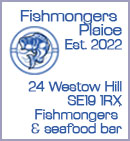

• Click on images to enlarge
The village centre was near Dulwich Hamlet
school and it was originally in the county of Surrey. The name comes
from OE and may have meant 'meadow where the dill grew'
Saxon Dulwich
967 Edgar the Peaceful (c.933-975) granted Dilwihs to a thane, Earl Aelfheah.
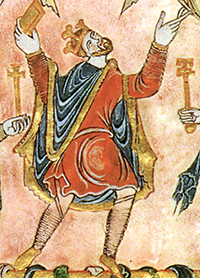
Medieval Dulwich
1127 Dulwich given to Bermondsey Abbey by Henry II.
1333 Dulwich's Population: 100.
The boundary with Friern Manor (ie East Dulwich) was Lordship Lane.
Tudor Dulwich
1538 After Dissolution of Monasteries Dulwich was seized by the Crown.
1544 Manor of Dulwich sold to goldsmith Thomas Calton by Henry VIII for £609.
1586 Thomas Calton died & Estate passed to his 10-year old grandson Francis Calton, who later became Lord Mayor of London.
Stuart Dulwich
1605 After some bad investments Francis Calton sold Dulwich estate to the actor/manger Edward Alleyn (1566-1626).
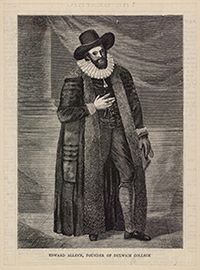
1613 Work on Dulwich Chapel and Old College began.
1616 Dulwich Chapel finished.
Old Burial Ground added.
1618 Old College opened.
1619 Foundation of College of God's Gift by Alleyn College endowed with manor of Dulwich by Edward Alleyn.
The College of God's Gift was for twelve poor scholars - six poor brethren and six poor sisters.
1626 Edward Alleyn died.
1647 Roundheads quartered in Old College during the English Civil War.
1665 Great Plague killed 35 inhabitants of Dulwich.
1686 Actor William Cartwright (1606–1686) bequeathed a collection of 239 pictures to the College.
1712 James Allen (1683-1746) took the role of Warden and master of Dulwich College.
Georgian Dulwich
1739 Pond House, Village Way, built.
1740 Dulwich Spa established by William Cox, owner of the Green Man (later Grove Tavern) on the corner of Dulwich Common and Lordship Lane.
Cox’s Walk cut to link Dulwich Spa with Sydenham Wells.
1741 James Allen established two small schools to be known as the Dulwich Free School. Were first set up in a local tavern.
1750 Print of old Dulwich College

1757 Lyndhurst, Village Way, built.
1775 College permitted residents to enclose the Green surrounding their houses with posts and bars (now chains).
1785 Belair House built, possibly by Robert Adam.
1789 Dulwich Toll Gate opened on College Road.
1799-1801 Byron attended Dr Glennie's Academy (previously The Green Man) opposite Cox’s Walk.
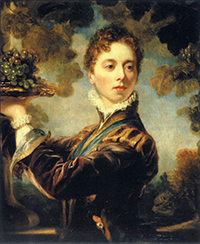
1800s Highwaymen on Dulwich Common
1805 An Act allowed Dulwich College to enclose and develop 130 acres of common land within the Manor.
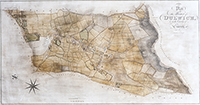
1808 The Dulwich College Building Act extended the period of which leases ran from twenty-one years as laid down by Alleyn, to eighty-four years.
Artist David Cox (1783-1859) settled in Dulwich.
Regency Dulwich
1811 Painter Peter Francis Lewis Bourgeois RA (1753-1811) requested in his will the construction of a gallery in Dulwich, designed by John Soane, in which to display his collection
1817 Dulwich Picture Gallery by John Soane (1753-1837) opened. Became first public art gallery in Britain in continuous use.
1814 Windmill at Dulwich Common closed.
1820 Print of Dr Glennie’s Academy on the corner of Dulwich Common and Lordship Lane
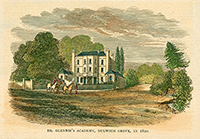
c1825 Dr Glennie's Academy closed
Charles Barry Snr (1795-1860) appointed architect to the Dulwich College Estate
Early Victorian Dulwich
1842 After criticism of its allocation of education, Dulwich College established the Dulwich Grammar School for the education of poor boys from Camberwell and Dulwich. It was designed by Charles Barry Snr. Boys were moved fro the Dulwich Free School. A Dulwich Girls’ School was established on site of present Dulwich Hamlet school.
1851 Dulwich's population: 1,632
1857 The Dulwich College Act. In it the Charity Commissioners stipulated that The College of God's Gift became reconstituted as Alleyn’s College of God's Gift.
The Grammar School was closed down. Two new schools were established under the name of Dulwich College: an Upper School and a Lower School .
1859 Belair House embellished.
Photo of original Alleyn’s Head on Park Hall Road.
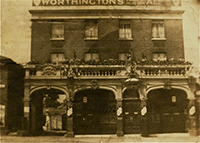
Mid Victorian Dulwich
1863 London Chatham & Dover Railway built through Dulwich Estate. Dulwich (later West Dulwich station) opened.
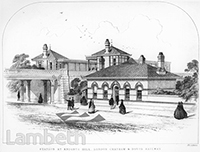
Dr Glennie's Academy rebuilt as The Grove Tavern.
1866 Payments from the railway company funded the building of new Dulwich College on College Road.
1868 North Dulwich station built by London, Brighton and South Coast Railway. Designed by Charles Barry Jnr (1823–1900).
1870 New Dulwich College by Charles Barry Jnr opened. Set in 40 acres. 300 pupils.
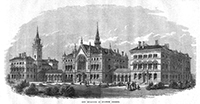
1872 CHA Voysey (1857-1941) attended Dulwich College. Later a prominent architect.
1875 St Stephen Church, South Dulwich by Charles Barry Jnr.
1878 Dulwich Girls’ School renamed James Allen’s Girls’ School.
Late Victorian Dulwich
1882 Lower School became independent became a separate part of the College of God's Gift as Alleyn's School in the Village.
1884 Dulwich Hamlet school (Boys) established.
1886 James Allen’s Girls’ School moved with 141 pupils to East Dulwich Grove.
1887 Alleyn's School relocated to Townley Road as a lower school for Dulwich College.
1890 Dulwich Park opened on site of Dulwich Court farm. Initially design by Charles Barry Jnr, it was further designed by Lt Col JH Sexby (Battersea Park designer).
1893 PG Wodehouse (1881-1975) attended Dulwich College.
1894 St Barnabas Church opened.
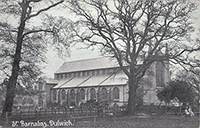
1895 Dulwich Hamlet FC formed. Club played at Woodwarde Road until 1895.
Crown pub demolished (site now Aysgarth Road)
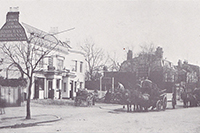
1896 Dulwich Hamlet FC played at College Fam for a year.
1898 Old Greyhound pub demolished
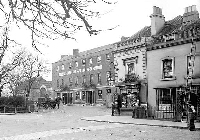
Edwardian Dulwich
Crown & Greyhound built on the site of the old Greyhound
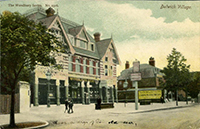
1900 Photo of Grove Tavern
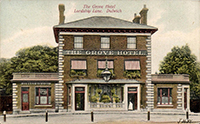
Raymond Chandler (1888-1959) attended Dulwich College.
1901 Dulwich's Population: 10,247
1904 Tower added to St Barnabas Church.
Vaughan Williams (1872-1958) became director of music at James Allen’s Girls’ School.
1911 CS Forester (1899-1966) attended Alleyn’s School. Later wrote the Hornblower novels.
Dulwich in First World War
1917 Bombing raid by German Gothas led to two deaths near Dulwich Park.
Inter-War Dulwich
1919 Alleyn's became a public school.
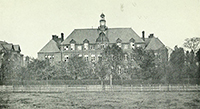
1920 Michael Powell (1905-1990) attended Dulwich College. Later a director of films.
1926 Dulwich railway station renamed West Dulwich station.
Dulwich in Second World War
The Blitz & V1 & V2 Flying Bombs caused widespread damage.
1944 Old Alleyn's Head damaged by VI rocket.
Another V1 rocket severely damaged the Dulwich Art Gallery and the Chapel and destroyed Gallery Cottage.
Post-War Dulwich
1946 Old Alleyn’s Head demolished.
1957 New Alleyn’s Head opened n on Park hall Road
1960 Philip Manzera (b.1951) attended Dulwich College. Later Roxy Music guitarist.
1966 Eight paintings valued at £1.5 million stolen from Dulwich Picture Gallery. Retrieved five days later by police.
1967 Celebration of Dulwich Millennium (colour film 23:58)
1976 Alleyn's became co-educational.
1992 St Barnabas Church, Dulwich damaged in an arson act.
1996 New Church of St Barnabas by HOK Architects.
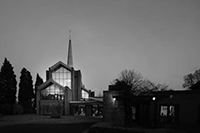
2000 North Dulwich Charter School opened.
2017 Crown & Greyhound restored and accommodation added.
Further Reading
Memoirs of Edward Alleyn - J Payne Collier (Shakespeare Society 1841)
Dulwich History and Romance AD 967-1916 - Edwin T Hall (Bickers 1917)
Dulwich Discovered - William Darby (1966)
Dulwich A Place in History - William Darby (1967)
The Story of Dulwich - Mary Boast (London Borough of Southwark 1975)
God's Gift: A Living Image of Dulwich College - Sheila Hodges (1981)
Around Dulwich - Brian Green (Village Books 1982)
Dulwich Village - Brian Green (Village Books 1983)
Victorian & Edwardian Dulwich - Brian Green (Quotes Ltd 1988)
Dulwich The Home Front - Brian Green (Dulwich Society 1995)
Dulwich A History - Brian Green (College Press 2002)
Dulwich Picture Gallery Complete Illustrated Catalogue (Unicorn 2002)
Soane's Favourite Subject: The Story of Dulwich Picture Gallery - Francesco Nevola (2003)
Dulwich Park - Liz Johnson (2005)
Dulwich College A History 1616 -2008 - Jan Piggott (2008)
How a King's Art Collection Came to London: the History of Dulwich Picture Gallery - Jan Piggott (2012)


